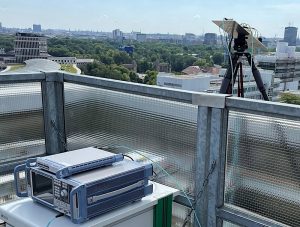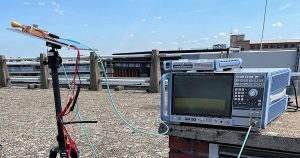As 5G networks for cellular service have slowly made their way around the globe, engineers at multiple telecommunications companies have been hard at work on next-generation 6G communications technology. Moving to the new technology is expected to push data transmission speeds to 50 times faster than 5G. It is also expected to cut latency to just 10% that of 5G, making conversations sound more natural. And the new standard is also expected to improve the accuracy of the data sent. Together, these improvements could drive a wave of new “Internet of Everything” development, with new devices aimed at both the home and workplace.

Scientists have long recognized that achieving the next step in transmission technology will be more difficult than those that came before due to a major problem with 6G signaling; it is short-range due to loss of power as it is transmitted. For this reason, the global standards body for data communications has set its commercialization date for 2025, while most in the field do not expect actual sales to begin until 2029 or later.
Just a few months ago, a team at Samsung set a new distance record for sending 6G signals—15 meters. The researchers on this new effort have gone much farther, sending a signal 100 meters from the top of one tall building to another tall building. And the key to their success, the company claims, is an amplifier jointly developed with Fraunhofer-Gesellschaft, which is capable of generating stable signals at up to 15 dBm in frequency ranges between 155 and 175 GHz. The team was also able to demonstrate adaptive beamforming—a necessary feature for allowing changing channels along with the position of a receiver.
They also were able to conduct high-gain antenna switching, which is necessary for combining multiple signals and sending them to a targeted antenna.

I admit I hadn’t considered software design as a major contributor to greenhouse gas. But the folks at the foundation make a compelling case that as everything becomes more connected, the way we build the software can have profound impacts. Asim Hussain, green cloud advocacy lead at Microsoft and executive director of the Green Software Foundation, commented in an email:
“We often look at sustainability in tech through the lens of hardware, focusing on how to make hardware more carbon-efficient. Relatively little has been done to look at sustainability through the lens of software. From where we are sitting, there seem to be some ripe easy pickings for sustainability improvements by looking at how we run software on hardware.”
What is ‘green software’?
Green software takes into account sustainability considerations and climate science to design software that is “carbon-efficient” — meaning it minimizes the number of carbon emissions per unit of work. It takes into account factors such as energy efficiency within its design.
At the risk of getting wonky, the foundation broadly divides this software into different buckets:
- Carbon-efficient applications that more efficiently use resources linked to carbon emissions.
- Carbon-aware applications that change behaviour to minimize carbon emissions.
Cumulatively, this type of software could have a significant impact. The software runs billions of internet-connected devices, from phones and refrigerators to data centres and personal computers. The foundation says that 20% of electricity output will be consumed by information and communications technology by 2030. The group has a goal to reduce emissions related to the industry’s software by 45% by 2030.
The foundation’s strategy is three-pronged: develop standards and best practices to make software consume less energy; support open-source innovation; and facilitate an international community. Hussain added:
“We think we can pull some pretty big levers through just growing the ecosystem of people with the skills to build software that emits less carbon, as well as creating standards that organizations can easily adopt or that might influence policy decisions.”
The data centre example
Data centres are energy hogs. They’re also essential to our ever-connected world, and their energy demands are huge and expected to grow. In 2018, research suggests data centres were responsible for about the same amount of carbon emissions as aviation. Today, they’re responsible for 1% of global electricity demand, with projections that the segment will consume 3 to 8% within the next decade.
While that is a tremendous amount of energy, data centre consumption is less than we thought it would be 15 years ago. Energy use in data centres doubled from 2000 to 2005, a trend we thought would continue. Between 2010 and 2018, computing output jumped sixfold — but energy consumption rose only 6%.
In part, that’s thanks to the rise of cloud computing, which allows companies and individuals to use centralized data centres for computing and storage. Additionally, data centres have become more efficient. The software has had a big role to play and can do much more. Google, for example, is working towards 24/7 clean energy for its data centres with the help of carbon-aware software.
These increased efficiencies illustrate how difficult it is to predict the future of disruptive technologies. It also reflects how tech companies, founded on the ethos of innovation, are positioned to reinvent their processes.
]]>